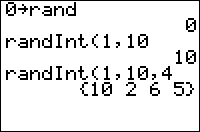TI-BASIC:Randint
Command Summary
Generates a random integer between min and max, inclusive, or a list of such numbers.
Command Syntax
randInt(min,max[,# of numbers])
Menu Location
Press:
- MATH to access the Math menu.
- LEFT to access the PRB submenu.
- 5 to select randInt(, or use arrows.
TI-83/84/+/SE
2 bytes
randInt(min,max) generates a uniformly-distributed pseudorandom integer between min and max inclusive. randInt(min,max,n) generates a list of n uniformly-distributed pseudorandom integers between min and max.
seed→rand affects the output of randInt(.
0→rand
0
randInt(1,10)
10
randInt(1,10,5)
{10 2 6 5 8}
Optimization
When the lower bound of randInt( is 0, you can replace it with int(#rand to save space. For example:
:randInt(0,12 can be :int(13rand
Similarly, if you don't want to include zero in the range, you can use a variant of 1-#int(#rand:
:1-2int(2rand
In this particular example, the only values that you will ever get are -1 or 1.
Formulas
The value of randInt( for a given seed can be expressed in terms of Rand:
randInt(A,B)=
- when A<B, A+int((B-A+1)rand
- otherwise, B+int((A-B+1)rand
This is identical to the output of randInt( in the sense that for the same seed, both expressions will generate the same random numbers.
Error Conditions
- ERR:DOMAIN is thrown if any of the arguments is a decimal.
- ERR: DATA TYPE is given if you use imaginary numbers like 6i or something like Matrices or Lists. This error is used instead of ERR:DOMAIN for "i".
